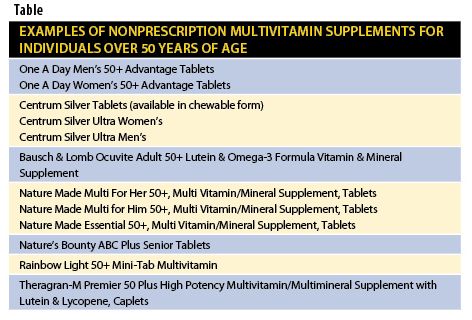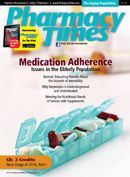Nonprescription Multivitamin/Mutimineral Supplements: Meeting the Nutritional Needs of Older Patients
Pharmacists can help seniors select supplements to meet their daily nutritional needs to ensure an active and healthy life.
Pharmacists can help seniors select supplements to meet their daily nutritional needs to ensure an active and healthy life.
Many people have elected to use a multivitamin/multimineral supplement to help meet their daily nutritional needs. Statistics report that an estimated 50% of individuals in the United States take multivitamin/multimineral supplements and spend a combined estimated amount of $23 billion annually.1 Since dietary supplements are commonly used by individuals who are over 50 years of age, pharmacists are in a pivotal position to assist patients in the proper selection of these multivitamin/multimineral supplements.2 Studies report that deficiencies of vitamins and important minerals have been observed in almost 33% of elderly patients, especially those who are homebound, frail, and have chronic illness.3,4 These patients may be ideal candidates for some form of nutritional supplementation.4

Examples of other factors that may warrant nutritional supplementation include poor nutrition, lower caloric intake, physical limitations, chewing difficulties, having multiple medical conditions, and being on a fixed income5,6 Additionally, since older individuals are more likely to take multiple prescription and nonprescription medications, various drug/nutrient reactions may occur. The use of some pharmacologic agents may cause a decrease in appetite, which may therefore negatively affect an individual’s nutritional status.
A host of multivitamin/multimineral supplements formulated to meet the nutritional needs of individuals over 50 years of age are currently on the market. Gender-specific formulations are available to meet the individual nutritional needs of men and women. Examples include Bayer’s One A Day Men’s 50+ Advantage and One A Day Women’s 50+ Advantage, and Centrum Silver Ultra Women’s and Centrum Silver Ultra Men’s supplements.
In general, supplements formulated for those over 50 years of age may include larger amounts of vitamin C, folic acid, vitamin D, vitamin E, and vitamins B1, B2, B6, and B12, but no iron, since individuals in this patient population generally meet their iron needs through diet alone.7-9 Some studies suggest that high iron stores may contribute to conditions such as cancer and cardiovascular disease, however; to date there is no conclusive research to support this theory.5, 6,7 Some formulations also contain ginkgo biloba for improved memory and concentration. Nature’s Bounty has formulated multivitamin/ multimineral supplements geared for individuals 45 years and older, which are marketed as Your Life Multi Men’s 45+ and Your Life Multi Women’s 45+. These formulations contain 39 different nutrients including 12 vegetable and fruit concentrates, antioxidants, probiotics, and omega-3 fatty acids.10
Prior to recommending any multivitamin/ multimineral supplement to patients in the older population, pharmacists should assess the patient’s medical history and medication profile to determine if there is a potential for a drug/micronutrient interaction or contraindication. Patients should be reminded that these supplements are intended to prevent nutritional deficiencies and maintain nutritional stores and are not intended for the self-treatment of vitamin deficiencies.4
Patients with severe nutritional deficiencies should always be referred for further medical evaluation. Pharmacists should also determine if the patient is currently taking any other nutritional supplements, to avoid therapeutic duplications.
Patients should also be reminded to take supplements as directed and adhere to a diet consisting of a wide variety of foods to ensure balanced and optimal nutrition for an active and healthy life. PT
References:
1. Multivitamins don’t reduce diabetes risk. Medline Plus Web site. http://www.nlm.nih.gov/medlineplus/news/fullstory_105199.html?print=y.
2. Davidow L. Self care and nonprescription pharmacotherapy. In Berardi R, Newton G, McDermott JH, et al, eds. Handbook of Nonprescription Drugs. 16th ed. Washington, DC: American Pharmacists Association; 2009:7.
3. Vitamins. MD Consult Web site. www.mdconsult.com/das/patient/body/168862454-5/911756995/10041/9477.html. Accessed November 1, 2010.
4. Should everyone over age 75 take a multivitamin? Cleveland Clinic Web site. http://my.clevelandclinic.org/heart/prevention/alternative/vitamins_elderly.aspx. Accessed November 10, 2010.
5. Huckleberry Y, Rollins, C. Essential and conditionally essential nutrients. In Berardi R, Newton G, McDermott JH, et al, eds. Handbook of Nonprescription Drugs. 16th ed. Washington, DC: American Pharmacists Association; 2009:389-417.
6. Ervin RB, Kennedy-Stephenson J. Mineral intakes of elderly adult supplement and non-supplement users in the third national health and nutrition examination survey. J Nutr. 2002;132(11):3422-3427.
7. One A Day Vitamins [product information]. Bayer Consumer Web site. www.oneaday.com. Accessed November 10, 2010.
8. Centrum Silver [product information]. Wyeth Consumer Health Web site. www.centrum.com. Accessed November 10, 2010.
9. Nature Made Vitamins [product information]. Pharmavite LLC Web site. www.naturemade.com. Accessed November 9, 2010.
10. Your Life Multivitamin [product information]. Nature’s Bounty Web site. www.naturesbounty.com/pages/whatsnew.aspx. Accessed November 9, 2010.
Ms. Terrie is a clinical pharmacy writer based in Haymarket, Virginia.

